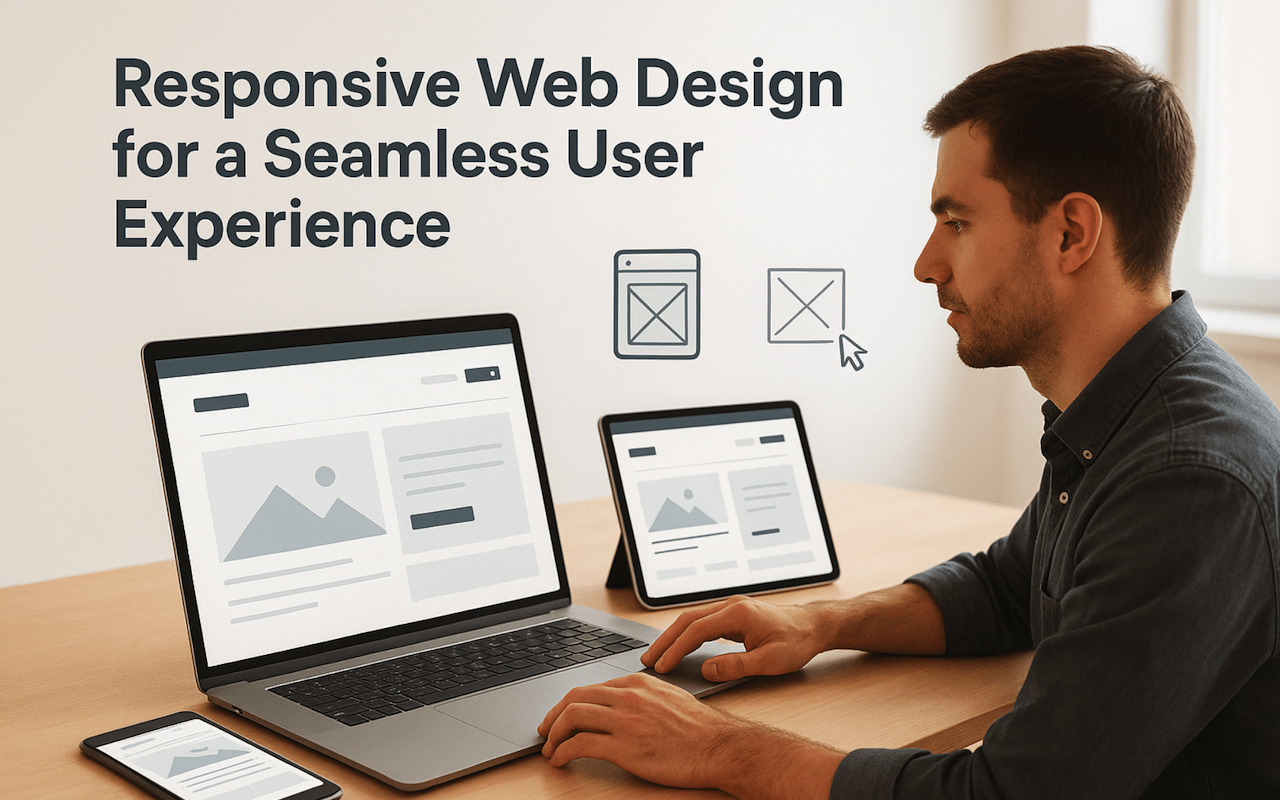
In an ever-evolving digital world where users reach your website from multiple devices, responsive web design is not optional; it's mandatory. Users expect a clean and consistent experience whether they're using their laptop, tablet or smartphone. For e-commerce businesses, this expectation is even greater, as customers often compare products across multiple platforms, brand websites, and competitors before making a purchase. A smooth, uniform experience across all screens is crucial, not just for aesthetics, but for driving conversions, establishing credibility, and ensuring long-term brand sustainability. In this article, we’ll explore the key benefits of responsive web design for both user satisfaction and your competitive standing in the e-commerce landscape.
What Is Responsive Web Design?
Responsive web design (RWD) is a design approach that allows your website to automatically adjust all elements on the page to any size screen and in any orientation. Responsive design doesn't require you to create a separate version for each type of device. Rather, it uses flexible grids, frames, and CSS media queries to modify content based on the user's viewing experience.
For example, a user accessing your online store or service website, such as an Amazon listing optimization website, from a smartphone should have the same experience as one viewing it on a desktop, consistent navigation, design, and usability across both devices. RWD aims to provide the same experience, a site that looks and feels as good on a mobile display as it does on a laptop.
Why Responsive Design Matters More Than Ever
Modern shoppers want speed, clarity, and usability from every online experience. Mobile devices now account for over 60% of web traffic, and on average, most users will leave a site if it is not optimized for mobile use.
For online businesses and digital brands, responsive design also brings specific benefits:
- Trust and Professionalism: Brands that are selling a digital or e-commerce service must demonstrate that they have technical knowledge. Responsive web design issues badly damage credibility right at the outset.
- More Engagement: A responsive website allows users to skim from page to page quickly, linger for longer on pages, and produce a higher average number of pages viewed, all of which lead to better outcomes in the SEO space.
- Increased Conversions: If potential customers can quickly understand your products or services on a mobile device, they are more likely to activate as a customer.
In short, responsive design creates a more intuitive connection with both your audience's needs and desires and your marketing goals.
How Responsive Web Design Impacts User Experience
1. Uniformity Across Devices
The best feature of responsive web design is that it is consistent and familiar across multiple screens. For example, a visitor may review your product page or service offerings on their desktop during the work day, and at another time of the day, he may return to the site on his phone. When faced with responsive design, everything feels familiar: familiar colors, familiar menus, familiar images, and familiar call-to-action buttons.
This unity and familiarity builds trust and comfort so that the user does not feel lost or frustrated when switching to a different screen.
2. Faster Load Times
Page speed is a defining factor in user experience and search engine ranking. Responsive websites are built to optimize performance by resizing images, minimizing scripts, and using adaptive content delivery.
In the competitive world of online retail, where clients compare multiple providers, even a few seconds of delay can cost you a lead. A fast, responsive site keeps visitors engaged and conveys a sense of technical reliability, exactly what your customers expect from a professional online business.
3. Improved Mobile Usability
As mobile traffic continues to dominate the internet, responsive design guarantees that users can read, scroll, and engage with your site on small screens. Menus turn into accessible navigation bars, text is auto-adjusted for reading, and buttons are still easy to tap.
Focusing on mobile-first usability not only enhances the user experience but also aligns with Google’s mobile-first indexing, improving both search visibility and organic reach.
Responsive Design and SEO: A Perfect Partnership
Search engine optimization and responsive design are complementary strategies. Google favors mobile-friendly websites and as such, deploys favorable rankings to responsive websites.
For e-commerce and service-based businesses, the SEO benefits extend beyond improved visibility. Clients searching for "Best Product Listing Optimization" or "Amazon SEO Experts" or similar terminology will access your website since all of your sites are both quick and responsive.
Responsive web design eliminates duplicate mobile and desktop URLs; all SEO improvement efforts are on a single domain.
The ultimate result is:
- Greater crawlability
- Lower bounce rates
- Higher keyword ranking potential
Uniform website structure ensures that every page, from your homepage to your product or portfolio pages, enhances your overall online presence.
Integrating Responsive Design With Product Pages
For businesses managing digital storefronts, responsive design is not limited to just your own site! It also has an effect on how product pages look on different devices.
Here’s how these principles align:
- Consistent Visual Storytelling: Just as responsive web design focuses on visuals going across the screens, accessible and optimized product pages should display an aesthetically cohesive brand using images and formatting on both a desktop and mobile.
- Fast and Lightweight Content: Your product itself should include optimized media (both in terms of speed and image quality) to give it a professional look, while still keeping the site speed up for customer satisfaction.
- User-Based Design Thinking: Know how your "target" audience browses, whether they are browsing on mobile applications or on desktop. That will determine your website layout and the way you design product listings or service pages for the audience to gain understanding and conversion.
- Cross-Platform SEO Consistency: When using keywords properly on your website copy, or product listing content, you will find customers. Whether it is your potential client(s)/customer(s) finding your work on any platform; if you have a strong, and hopefully clear, message!
Applying responsive design principles across your entire digital presence reinforces your brand identity and positions your business as an authority in e-commerce optimization.
Practical Tips for Implementing Responsive Design
If you’re building or redesigning your site to improve responsiveness, keep these best practices in mind:
- Take a Mobile-First Approach: Focus on the smallest viewport of the mobile device and design up from there. This way, you are working from mobile-first design as a priority rather than an afterthought.
- Optimize Images and Media: Use adaptive images which will resize automatically along with media in the latest formats such as WebP to enable faster loading time.
- Make Navigation Easier: Consider replacing complex menus with fewer, more understandable clear dropdowns, or hamburger menu icons that are simple to navigate with touchscreens.
- Test on All Devices: Consistently check how the website content looks on mobile phones, tablets, and desktops. Test with Google’s Mobile-Friendly Test or BrowserStack so you can see issues earlier in the process.
- Use Analytics and Heatmaps: Gain a full understanding of user behavior: where your visitor clicks or scrolls and where they drop off. Understanding user behavior helps you design layouts that drive stronger engagement, especially for brands optimizing their online presence or digital storefront, where design choices directly influence buyer perception and conversion rates.
- Keep Branding Consistent: Make sure the color palette, fonts, and tone are consistent across all devices and platforms. User experience has to be catered to a strong, visual brand recognition from the first impression made and then a continuous experience exemplifies the brand.
The Connection Between Responsiveness and Conversion
A responsive website not only improves the user experience. This also has a direct impact on your bottom line. If visitors feel they can navigate your site easily, they will trust your services, spend more time on your site, and ultimately reach out to make an inquiry or purchase.
For example, a potential customer exploring your services may first view your blog post on mobile, bookmark it, and eventually visit your contact page on desktop. If both experiences are seamless, their trust in your professionalism increases.
This is the power of a well-thought-out responsive design. It builds trust and encourages users to take action through cohesive design.
The Future of Responsive Web Design
The development of responsive design does not stop at simply being adaptable to specific technologies. As technologies advance, websites will need to adapt not only for device capability, but for user interfaces that utilize AI-driven personalization, voice interfaces, and dynamic content delivery for each user.
Future-ready organizations will apply the principles of responsiveness to both the functional and visual aspects of their site, regardless of how each user accesses the website. Each user will receive a personalized, consistent, and efficient experience as it relates to their needs.
For businesses optimizing their online presence, you have to be prepared for e-commerce and digital platforms to evolve (i.e., AI-driven optimization and user experience changes). Your website should evolve strategically alongside changing digital trends while maintaining the innovation, reliability, and user-centered design that define modern web experiences.
Conclusion
Responsive web design is not only a technical standard; it’s also a statement about your brand’s commitment to the user experience and flexibility. In today’s world, a digital presence can either build or destroy credibility and a responsive site is the foundation for a consistent user experience.
For businesses offering digital products or services, creating a responsive web design is essential to start building trust, improve SEO, and maintain a competitive edge. A responsive, well-designed website indicates the same accuracy and attention to detail you will provide your customer in presenting their products or services, achieving alignment between design, functionality, and customer experience.
In conclusion, your website should speak the same language of your brand: responsive, relevant, and future leaning.
Share this post
Leave a comment
All comments are moderated. Spammy and bot submitted comments are deleted. Please submit the comments that are helpful to others, and we'll approve your comments. A comment that includes outbound link will only be approved if the content is relevant to the topic, and has some value to our readers.

Comments (0)
No comment